Note on Yatzy vs. Yahtzee: This guide is based on the classic Yatzy rules, common in Scandinavia and Europe (often associated with Alga). These rules differ from the North American Yahtzee (Hasbro) version. We cover the Yahtzee-specific rules in a separate section at the end.
Quick Facts (Yatzy)
- Players: 1+
- Playtime: 20–30 min
- Equipment: 5 dice, scorecard, pen (dice cup optional)
- Goal: Get 63+ points in the Upper Section for the bonus (50 points) and maximize points in the Lower Section.
Yatzy is one of those games that follows you through life. It's played on summer vacation, on long trips, at the kitchen table on a regular Tuesday, and during late nights when no one really wants to go to bed.
This guide covers how Yatzy works, how the points are counted, and strategies that can help you walk away victorious.
My name is Fredrik, and I work as a journalist by day, but I've dedicated a large part of my life to board games, not least Yatzy! My goal is to provide a complete guide to the game so that a beginner, after reading through this page, can win their first game of Yatzy and impress friends and family!
Quick Answers to Common Questions
- How do you get the bonus in Yatzy? You get the bonus (50 points) if you get a total of 63 points or more in the Upper Section of the scorecard (Aces to Sixes).
- Do you need three of each for the bonus? No, that's a myth. You just need 63 points total, regardless of how you get them (e.g., five sixes, five fives, and three fours is enough).
- How many points is a Yatzy? 50 points for the first one.
- How many dice do you use? 5 dice.
1. Introduction to Yatzy
What is Yatzy?
Yatzy is a dice game that has been around since the 1950s. This is largely due to the game's simple foundation: you roll dice, save the ones that help you, and try to find combinations that yield high scores.
It's equal parts luck and strategy, but I can promise you that the person who plans smart beats the person who plays planlessly, I can promise you that. Further down the page, you'll find rules of thumb and strategies that I use when I play.
Object of the Game
Roll dice for scoring combinations, and get the highest total score.
Equipment and Scorecard
To play Yatzy, you need minimal equipment:
- Five dice
- A pen or pencil
- A scorecard for each player
- A dice cup (optional)
One player is typically designated as the scorekeeper.
Download Scorecard (PDF & Printable)
Need a Yatzy score card? We offer free, printable Yatzy score cards that you can download instantly. These are designed to be clear and easy for beginners to understand.
- Download Score Card (Color PDF) - Great for printing on a color printer
- Download Score Card (Black & White PDF) - Perfect for home and school
Dice Combinations (Yatzy)
Each combination scores differently, as detailed in the scorecard sections.
| ACES – SIXES | Try to get as many as possible of the same number. |
| BONUS | A player who scores 63 points or more in the Upper Section gets 50 bonus points. |
| ONE PAIR | Two dice showing the same number. Scores total of the pair. |
| TWO PAIR | Two different pairs. Scores total of all four dice. |
| 3 OF A KIND | At least three dice showing the same number. Scores total of the three dice. |
| 4 OF A KIND | At least four dice showing the same number. Scores total of the four dice. |
| SMALL STRAIGHT | The five dice show 1-2-3-4-5. Scores 15 points. |
| LARGE STRAIGHT | The five dice show 2-3-4-5-6. Scores 20 points. |
| FULL HOUSE | Three of one number and two of another. Scores total of all 5 dice. |
| CHANCE | Any combination. Scores total of all 5 dice. |
| YATZY | All five dice show the same number. Scores 50 points. |
2. Gameplay: Step-by-Step
Preparations
Before the fun begins, make sure everyone is set up:
- Players: Yatzy can be played by 1 or more players.
- Equipment: Distribute a scorecard and pen to each player.
- First Player: To decide who goes first, each player in turn rolls all 5 dice. The player with the highest total goes first. Play then passes to the left.
The Three Rolls
On each turn, players roll the dice up to three times to get the best possible combination.
- First Roll: Roll all five dice.
- Reroll: After the first roll, you can choose to reroll any or all of the dice up to two more times. Keep the dice you like (your "keepers") and reroll the others to improve your chances.
- Final Roll: After the third roll, or if you’re satisfied earlier, you must use the current dice combination to fill in a category on your scorecard.
Example: On your first roll, you get two 6s, one 3, one 1, and one 4. You decide to keep the 6s and reroll the other three dice.
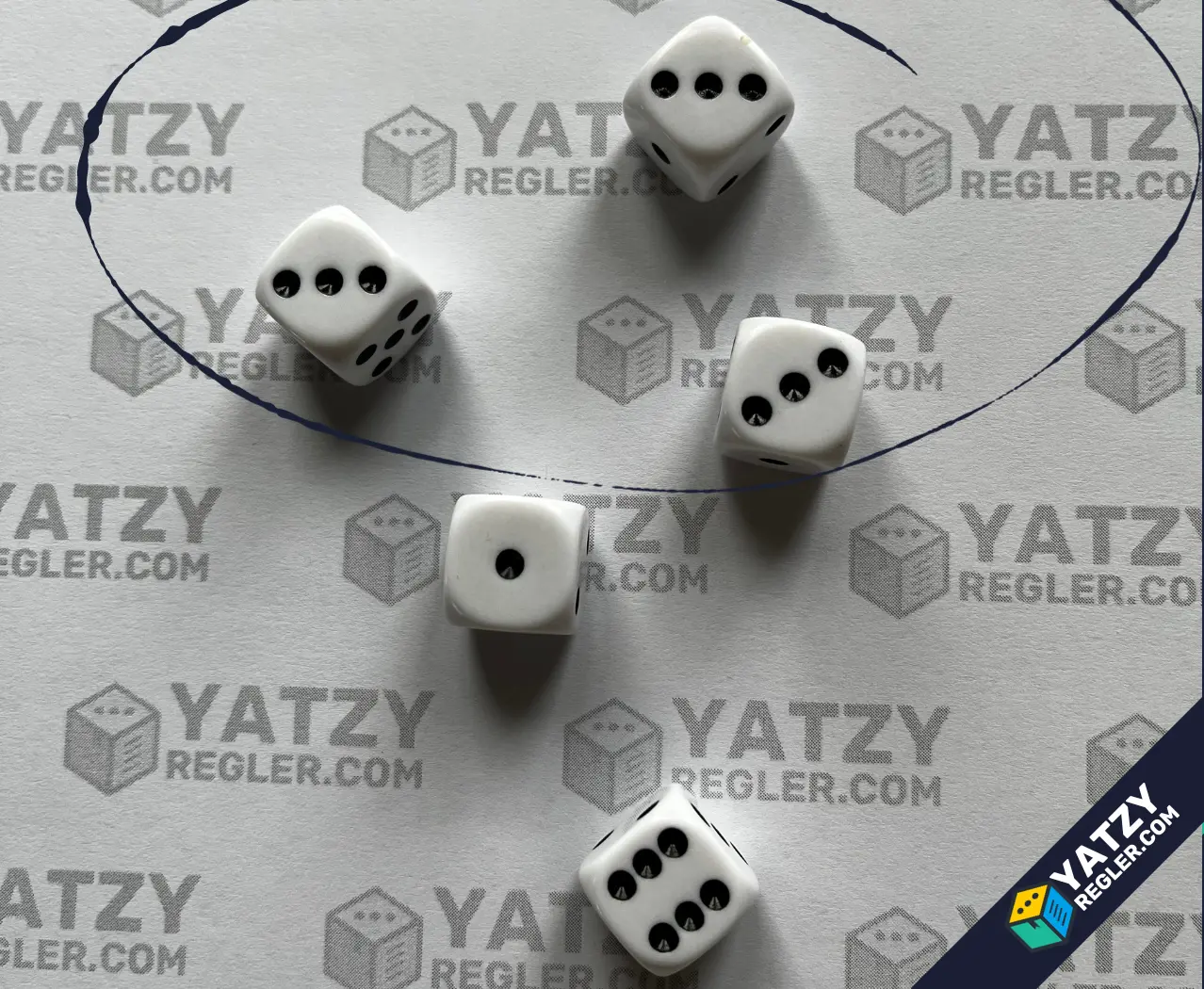
First roll - this is where you decide which dice to save.
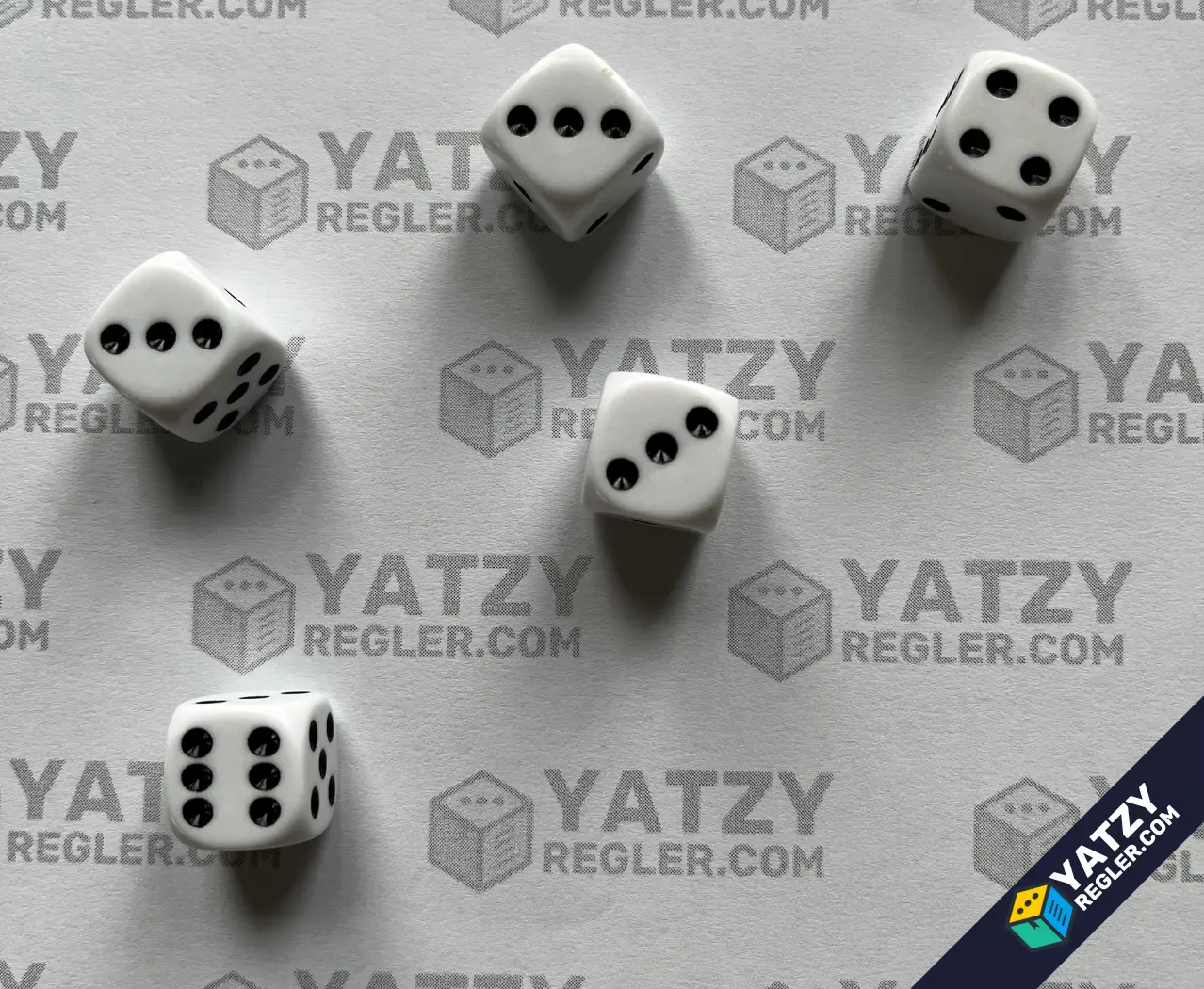
Second roll - re-roll the dice you didn't save.
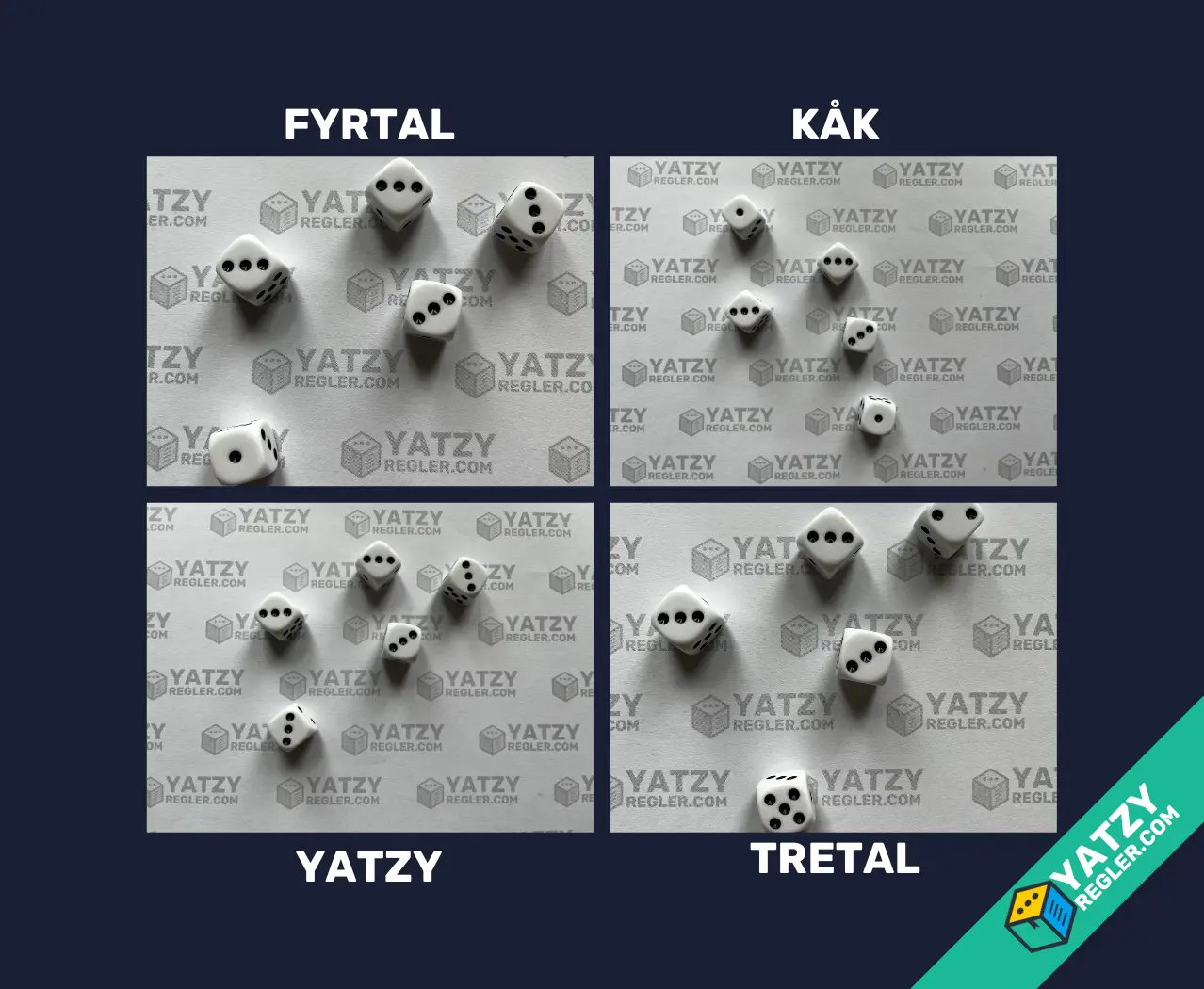
Third roll - your last chance to get the desired combination.
The Art of Saving Dice
Saving dice is about building a combination. You don’t need to declare which combination you’re rolling for; you may change your mind after any roll. You can even reroll "keepers" from a previous roll if you change your strategy.
Scoring: The Mandatory Choice
Each turn, you must choose one of the 15 categories from the scorecard to record your score.
- Each category can only be used once per game.
- You must fill in a box on each turn, even if you don't qualify for a combination.
Striking (Zeroing) a Box
If your rolls don’t match any of your available categories, or if the score would be very low, you must enter a zero in one of the categories. Choose wisely—try to zero out a category that you think will be hard to score later, like Yatzy or Large Straight.
3. The Scorecard: Heart of Yatzy
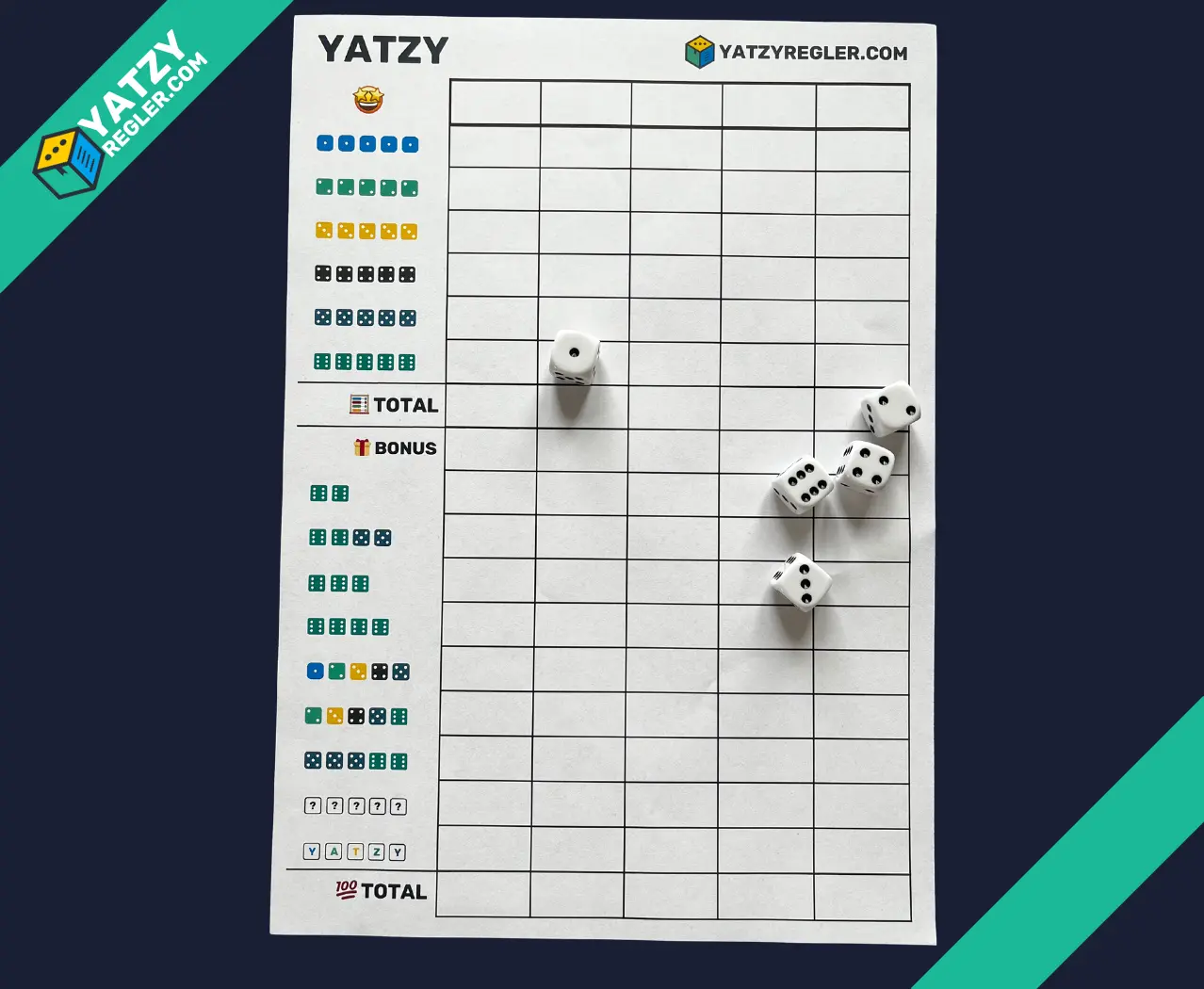
The Yatzy scorecard is divided into an Upper and Lower Section.
Overview: Upper and Lower Sections
| Section | Content | Goal |
|---|---|---|
| Upper Section | Aces, Twos, Threes, Fours, Fives, Sixes | Aim for at least 63 points for the bonus |
| Lower Section | Pairs, Straights, Full House, Chance, Yatzy | Maximize the value in each category |
The Upper Section
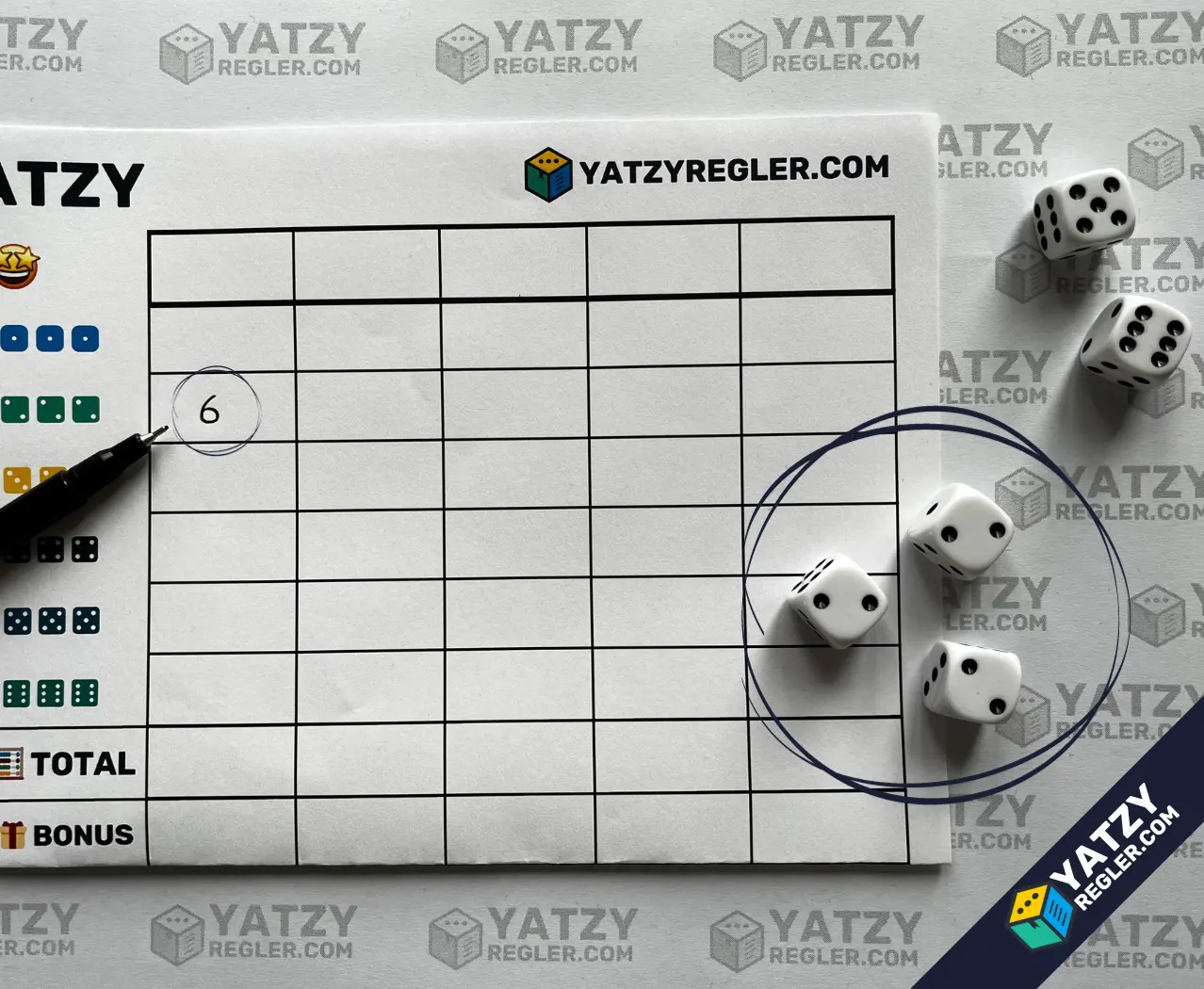
The Upper Section: Aces to Sixes - this is where you earn the bonus.
To score in the Upper Section, add only the dice with the same number and enter the total in the appropriate box.
| Upper Section | What to Score |
|---|---|
| Aces (Ones) | Total of Aces only |
| Twos | Total of Twos only |
| Threes | Total of Threes only |
| Fours | Total of Fours only |
| Fives | Total of Fives only |
| Sixes | Total of Sixes only |
For example, with the dice [⚂ ⚂ ⚂ ⚁ ⚃], you could score:
- 9 in the Threes box (3+3+3)
- 2 in the Twos box
- 4 in the Fours box
The Bonus: The Magic Number 63
Your goal in the Upper Section is to score a total of at least 63 points, to earn a 50-point bonus.
The 63 points are based on scoring three of each number (Aces through Sixes); however, you may earn the bonus with any combination of scores totaling 63 points or more.
The Lower Section

The Lower Section: Here you collect points through different combinations.
Each of the Lower Section scoring combinations is explained in detail below.
One Pair: Score in this box only if the dice include two of the same number. Score the total of the two dice.
- Example: [⚄ ⚄ ⚂ ⚁ ⚀] scores 5+5 = 10 points.
Two Pair: Score in this box only if the dice include two dice of one number and two dice of another. Score the total of these four dice. The two pairs must be different.
- Example: [⚃ ⚃ ⚁ ⚁ ⚅] scores 4+4+2+2 = 12 points.

3 of a Kind: Score in this box only if the dice include 3 or more of the same number. Score the total of the three dice.
- Example: [⚄ ⚄ ⚄ ⚁ ⚀] scores 5+5+5 = 15 points.

4 of a Kind: Score in this box only if the dice include 4 or more of the same number. Score the total of the four dice.
- Example: [⚁ ⚁ ⚁ ⚁ ⚅] scores 2+2+2+2 = 8 points.
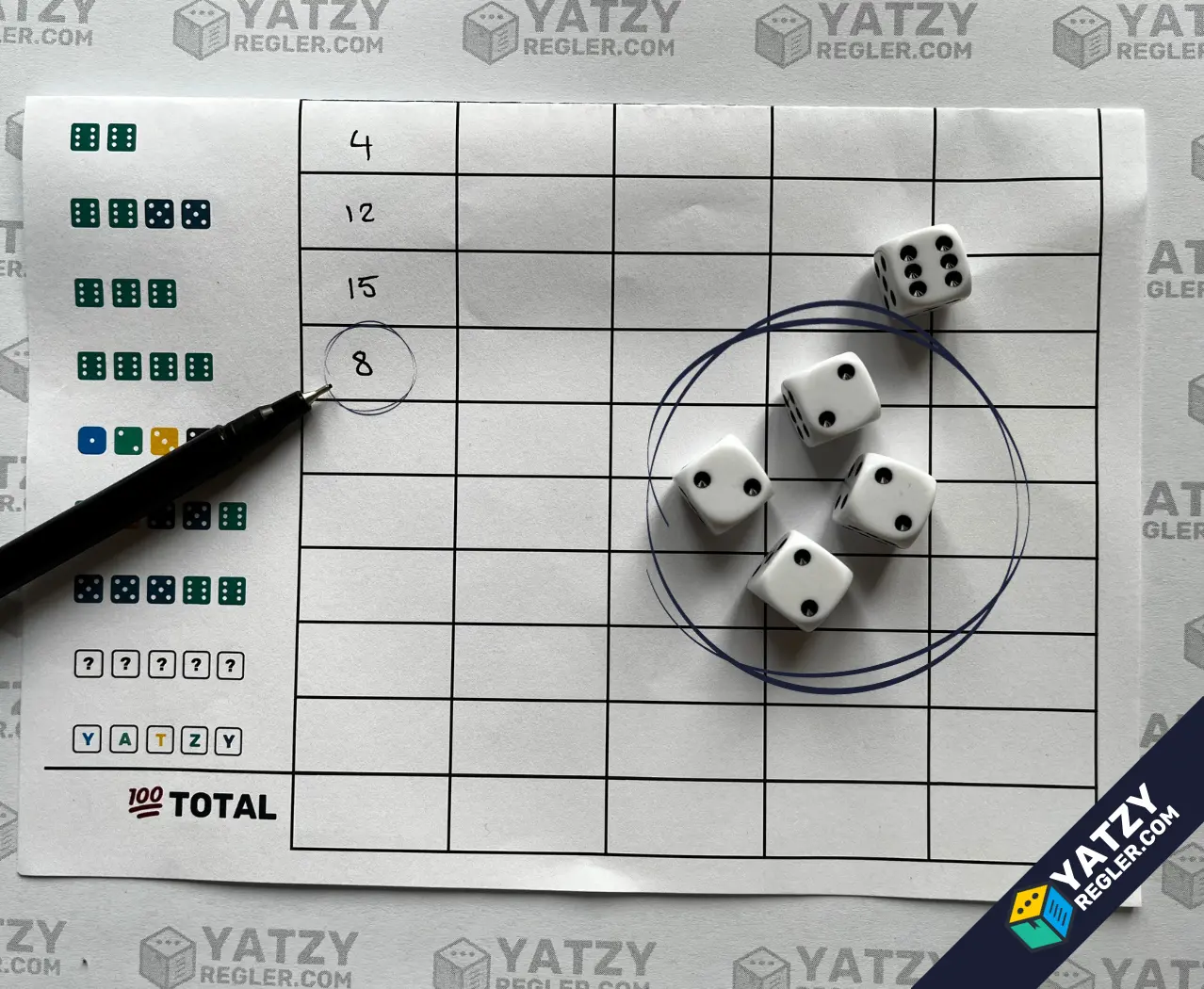
Small Straight: Score in this box only if the dice show the sequence 1-2-3-4-5. Scores 15 points.
Large Straight: Score in this box only if the dice show the sequence 2-3-4-5-6. Scores 20 points.
Full House: Score in this box only if the dice show three of one number and two of another. Score the total of all 5 dice.
- Example: [⚁ ⚁ ⚁ ⚂ ⚂] scores 2+2+2+3+3 = 12 points.
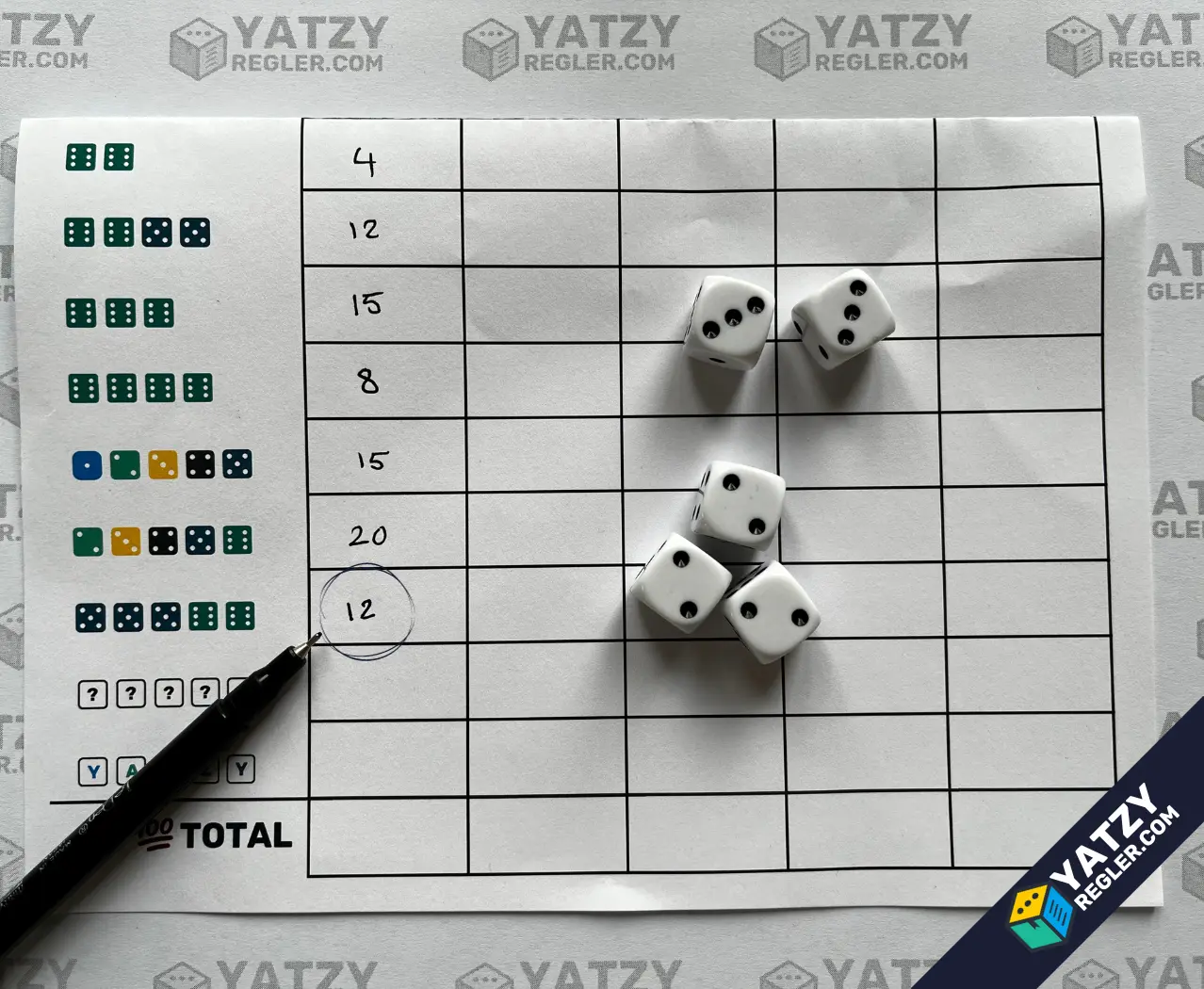
YATZY: Score in this box only if the dice show five of the same number (5 of a kind). A YATZY is worth 50 points.
Chance: Score the total of any 5 dice in this box. This catch-all category comes in handy when you can’t (or don’t want to) score in another category.
- Example: [⚂ ⚂ ⚅ ⚅ ⚅] scores 3+3+6+6+6 = 24 points.
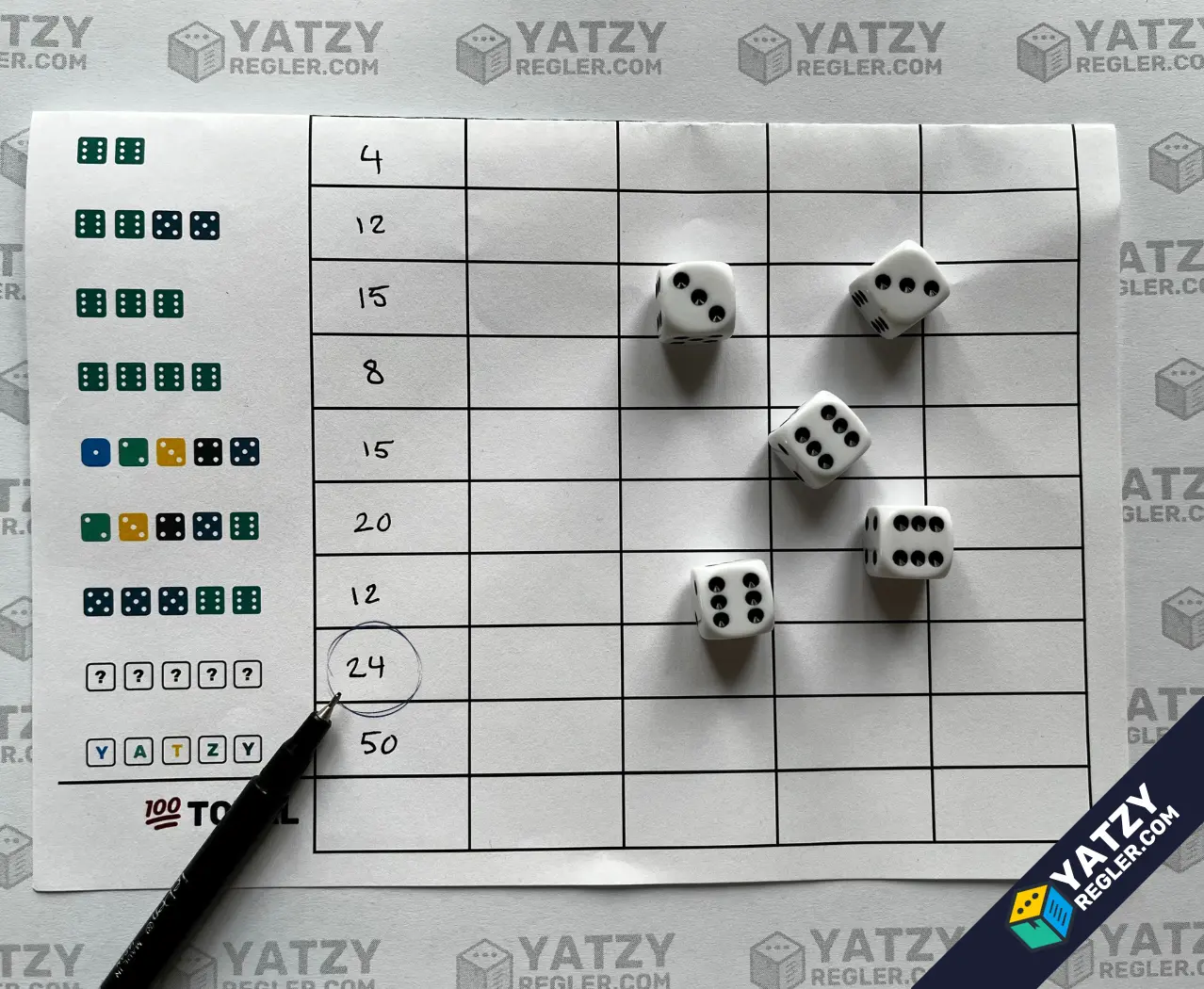
4. End of Game and Winner
When the Game is Over
The game ends after all players have filled in their entire scorecard, which happens after fifteen rounds.
Score Counting
Once each player has filled in all 15 category boxes, the game ends. Each player now adds up their score as follows:
- Upper Section: Add up the Upper Section scores (Aces to Sixes) and enter the total.
- Bonus: If the Upper Section total is 63 points or more, add the 50-point bonus.
- Lower Section: Add up the Lower Section scores (One Pair to Chance).
- Grand Total: Add the Upper Section total, Bonus, and Lower Section total. This is your final score.
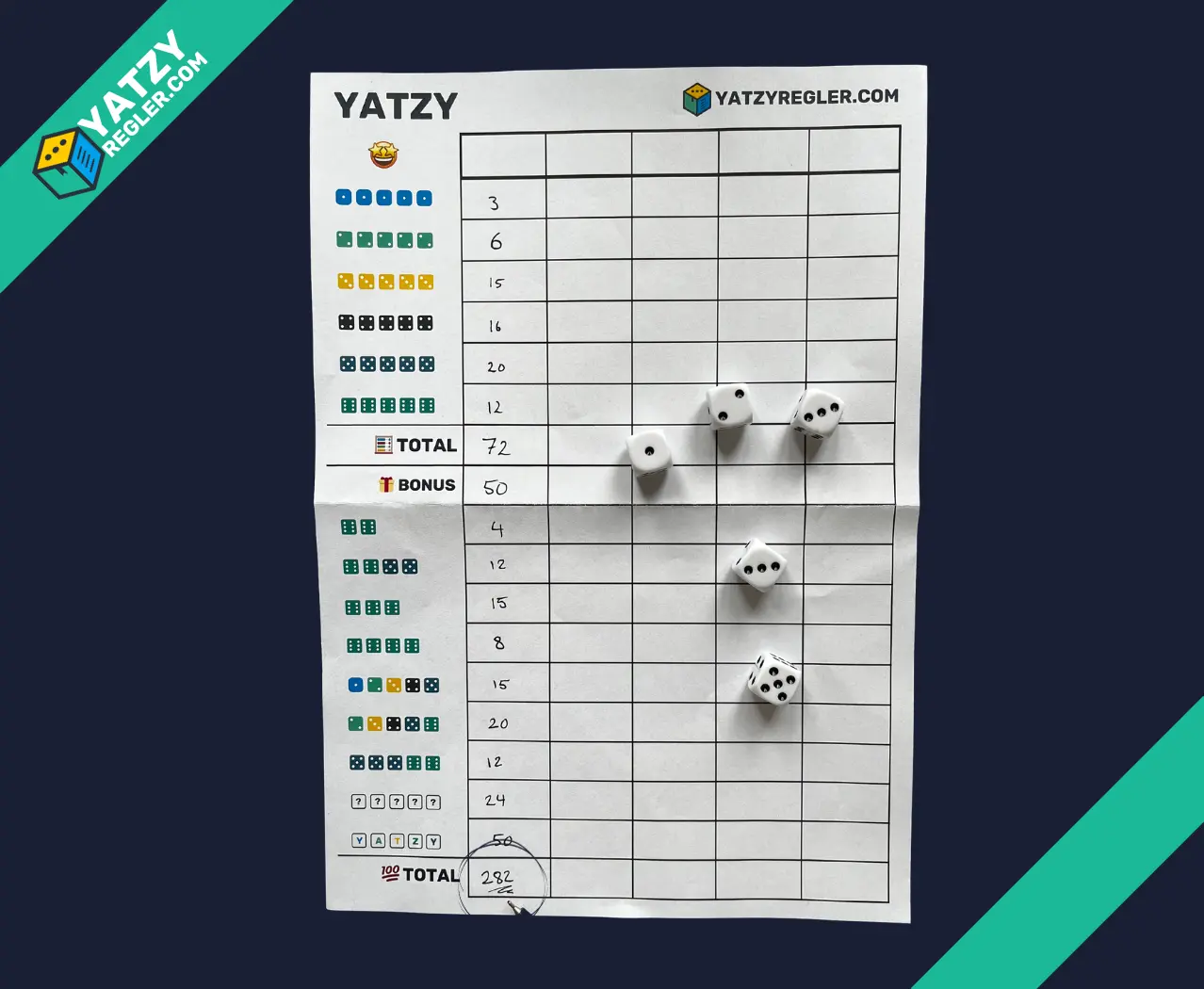
Winner
After the scores are tallied, the player with the highest Grand Total wins the game!
5. Strategies for Beginners and Experts
To maximize your score, you need more than luck. Follow these tips for smart rerolling decisions:
Tip 1: Prioritize the Upper Section Early
In the early rounds, aim to fill in your Upper Section. Scoring an average of three of each number (especially Fours, Fives, and Sixes) ensures you get the 50-point bonus. This can make a significant difference.
Tip 2: Strategic Rerolling for Lower Section
- Full House: Since this scores the total of all dice, a Full House with high numbers (e.g., 6-6-6-5-5 = 28 points) is much better than one with low numbers (e.g., 2-2-2-1-1 = 8 points).
- Straights: The straights (1-2-3-4-5 or 2-3-4-5-6) are hard to get because they require all 5 dice. Don't be afraid to "strike" (zero out) one of them, especially Small Straight, if a better roll is available.
- Pairs: Always score the highest pair possible. A pair of 6s (12 pts) is much better than a pair of 2s (4 pts).
Tip 3: Don’t Be Afraid to Use the Chance Category
If your rolls don’t match any good categories, use the Chance category. It’s better to score something than nothing! Try to get at least 20-25 points in this box.
Tip 4: Strike Smart
If you have to take a zero, be strategic. "Aces" is often the best box to sacrifice early, as the maximum score is only 5. Sacrificing a high-potential box like "4 of a Kind" or "Yatzy" can cost you the game.
6. Yatzy Variations
Here are the most common Yatzy variations.
Maxi Yatzy
Maxi Yatzy is an extended version played with six dice and a scorecard with more combinations.
- You roll 6 dice instead of 5.
- The bonus for the Upper Section is 100 points for reaching 84 points.
- New combinations are added, such as:
- Three Pair (e.g., 2-2, 4-4, 5-5)
- Full Straight (1-2-3-4-5-6), worth 21 or 25 points.
- House (two 3-of-a-kinds)
- Tower (a 4-of-a-kind and a pair)
- Maxi Yatzy (all six dice the same), worth 100 points.
Forced Yatzy (Tvångs-Yatzy)
The rules are identical to classic Yatzy, but with one major twist: you must fill the scorecard in order, from top to bottom. You start with "Aces," then "Twos," and so on. You cannot skip. This removes a lot of strategy and adds a lot of luck and frustration!
7. Yahtzee Rules: The North American Version
While this site is focused on Yatzy, many visitors look for the rules to the popular North American version, Yahtzee, as well. The gameplay is similar (roll 5 dice, 3 rolls per turn), but the scoring is significantly different.
Yahtzee Upper Section Scoring
This section is identical to Yatzy, but the bonus is smaller.
- Aces to Sixes: Score the total of matching dice (e.g., three 5s = 15 points in the "Fives" box).
- Bonus: If your total for the Upper Section is 63 points or more, you get a 35-point bonus.
Yahtzee Lower Section Scoring
This is where the main differences are. The Yahtzee scorecard only has 13 boxes in total.
- 3 of a Kind: You must have at least three identical dice. You score the total of all 5 dice.
- Example: [⚄ ⚄ ⚄ ⚁ ⚀] scores 5+5+5+2+1 = 18 points.
- 4 of a Kind: You must have at least four identical dice. You score the total of all 5 dice.
- Example: [⚁ ⚁ ⚁ ⚁ ⚅] scores 2+2+2+2+6 = 14 points.
- Full House: You must have three of one number and two of another. A Full House always scores a flat 25 points.
- Example: [⚂ ⚂ ⚂ ⚄ ⚄] scores 25 points.
- Small Straight: You must have four dice in a sequence (e.g., 1-2-3-4, 2-3-4-5, or 3-4-5-6). A Small Straight always scores a flat 30 points.
- Large Straight: You must have five dice in a sequence (1-2-3-4-5 or 2-3-4-5-6). A Large Straight always scores a flat 40 points.
- YAHTZEE: Five dice of the same number. This scores 50 points.
- Chance: Any combination. You score the total of all 5 dice.
Yahtzee Bonus & Joker Rules
This is a key feature of the Hasbro game.
- First Yahtzee: You score 50 points in the YAHTZEE box.
- Subsequent Yahtzees: If you roll another Yahtzee after having already scored 50 in the box, you get a 100-point bonus!
- Joker Rules: After scoring your 100-point bonus, you must fill another box on your scorecard with that roll.
- You must score in the appropriate Upper Section box if it is open (e.g., five 4s must be scored as 20 in the Fours box).
- If the appropriate Upper Section box is also filled, you may score in any open Lower Section box. Your roll (e.g., five 4s) counts as a valid "Full House" (25 pts), "Small Straight" (30 pts), or "Large Straight" (40 pts).
- If all other eligible boxes are filled, you must enter a zero in any open Upper Section box.
Download Yahtzee Scorecard (PDF & Printable)
Need a Yahtzee score card for the North American rules? We offer a free, printable Yahtzee score card that you can download instantly.
Download Printable Yahtzee Score Card
Key Differences: Yatzy vs. Yahtzee
This table shows a quick comparison of the different scoring.
| Category | Yatzy (This Guide) | Yahtzee (North American) |
|---|---|---|
| Upper Bonus | 50 points for 63+ | 35 points for 63+ |
| 3 of a Kind | Sum of the 3 matching dice | Sum of all 5 dice |
| 4 of a Kind | Sum of the 4 matching dice | Sum of all 5 dice |
| Full House | Sum of all 5 dice | Flat 25 points |
| Small Straight | 1-2-3-4-5 (5 dice) for 15 pts | 4-dice sequence (e.g., 1-2-3-4) for 30 pts |
| Large Straight | 2-3-4-5-6 (5 dice) for 20 pts | 5-dice sequence (e.g., 1-2-3-4-5) for 40 pts |
| Other Categories | One Pair, Two Pair | None |
| Yahtzee Bonus | None (in classic rules) | +100 points for each extra Yahtzee |
8. Common Questions (FAQ)
If you’re new to Yatzy or want to clarify some of the game’s rules, this FAQ section will answer the most common questions.
What is the difference between Yahtzee and Yatzy?
They are two different versions of the same core game. Yatzy (European) gives a 50-point bonus and scores combinations like "3 of a Kind" based only on the matching dice. Yahtzee (North American) gives a 35-point bonus and scores "3 of a Kind" based on the total of all 5 dice. See the full comparison table in Section 7.
Can Yatzy be played solo?
Yes, Yatzy is a great game to play solo! The objective is to beat your own high score.
What happens if you can’t score in any category?
You must enter a zero in one of the empty categories on your scorecard.
What is the best strategy for winning Yatzy?
The key is balancing risk and reward.
- Focus on getting the 50-point Upper Section bonus.
- Don't be afraid to take a zero in a low-scoring category (like Aces) or a hard-to-get category (like Large Straight) if it means setting up for a better score elsewhere.
- Use the Chance category for bad rolls that don't fit anywhere else (try to get over 20 points).
How do I score a Full House in Yatzy?
A Full House (three of one number and two of another) scores the total of all five dice. For example, 6-6-6-1-1 scores 6+6+6+1+1 = 20 points.
How do you break a tie in Yatzy?
The official rules do not specify a tie-breaker. Most players agree to a rematch or simply share the victory.
